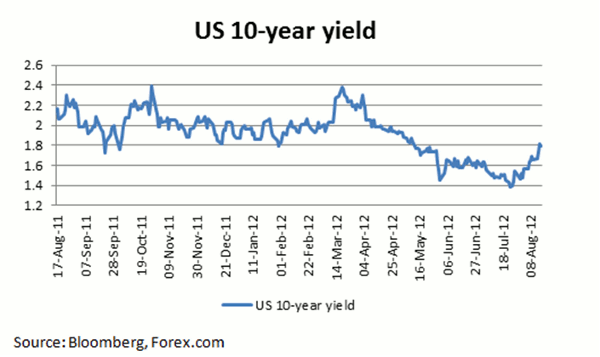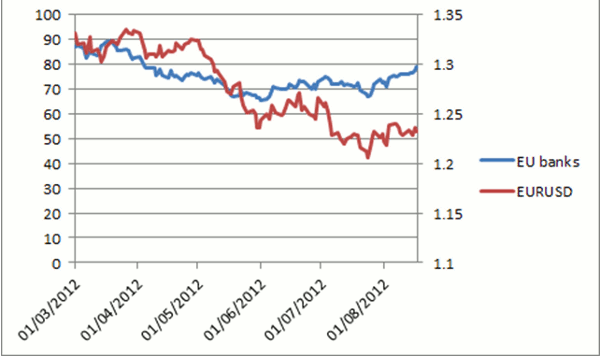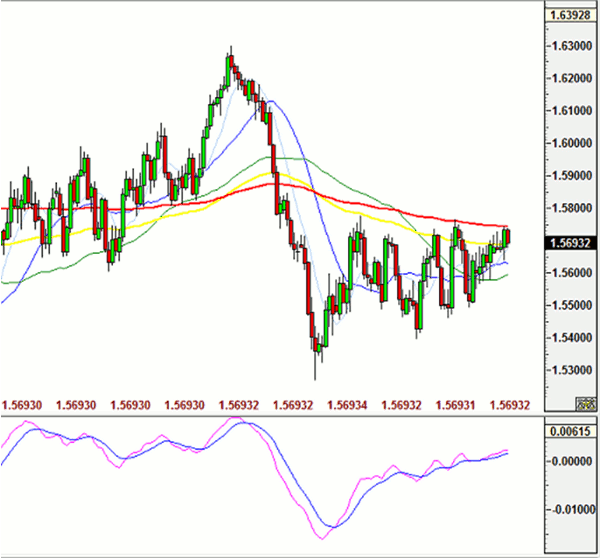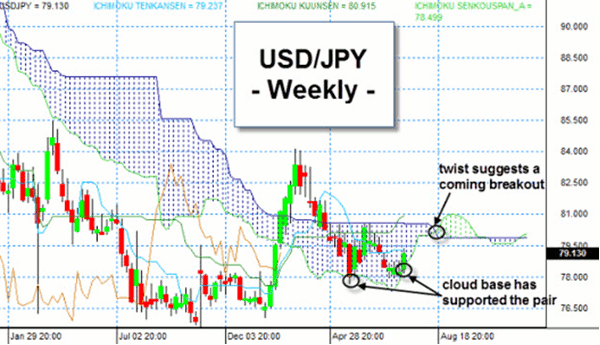Kathleen Brooks and Eric Viloria, CMT, of Forex.com outline the critical events and charts professional currency traders will be watching this week.
The Fed is about to release its meeting minutes from the July 30/August 1 FOMC meeting. The statement at that meeting was little changed from the June 20 FOMC statement, so any differences evident in the minutes will be of note.
At the beginning of this month, the committee was downbeat on the economy, and indicated a deceleration in economic activity in the first half, while changing its language to suggest it is moving closer to providing more accommodation. The minutes should provide further insight into the discussion regarding further easing and just how high the bar is before pulling the trigger on more stimulus.
While most of the market is focused on whether or not QE3 will be the next move, the Fed may have discussed other options, such as pushing out the forward-looking interest rate guidance, lowering the interest paid on excess reserves, or using the discount window.
With the improvement in economic data since the FOMC meeting concluded, markets have reduced expectations of action at the September Fed policy meeting. The pace of job growth has surprised to the upside, retail sales grew significantly, and housing data continues to improve. As a result, US Treasury yields have backed up with ten-year yields reaching levels that have not been seen since May (see Figure 1) as investors push out their expectations of more Fed easing.
Despite recent improvements, there is still more data to come before the FOMC meets again. Both the Fed and market participants will be closely monitoring the economic indicators to gauge the health of the economy and whether or not more support is required.
Europe Stabilizes...But for How Long?
The Eurozone crisis continued to show signs of stabilization last week. Spanish bond yields dropped below some key levels, and the ten-year yield is now below 6.5%, the lowest level since early July.
The markets are still reacting to signs that the ECB is in harmony with Germany. The latest sign that the Germans support what Draghi and Co. are doing at the central bank came from Chancellor Merkel, who said during a trip to Canada that her country is in line with the ECB’s approach to defending the euro. The ECB has yet to defend the euro, however...but it has said it would intervene in the debt markets of Spain and Italy if either country applied for a formal bailout complete with strict fiscal conditions first.
Thus, the ECB has stated its position, now it is up to Madrid to make the first move. However, as long as their bond yields are falling, it is unlikely that Madrid will preemptively apply for bailout funds when it can still fund itself in the capital markets. It may also resist applying for funds so that it doesn’t lose sovereign control over its budget in the process. This could eventually be one of the triggers to the next phase of the Eurozone crisis, in our view.
On paper, the rally in euro-based assets may look like it is on shaky foundations, but there have been some significant recoveries in some markets in recent weeks. Spain’s Ibex index is up more than 25% since July; even Athens’ stock index is up 33% since late May. This compares with an 18% increase in Germany’s Dax index and a 10% rise in the S&P 500 in the US.
It is worth pointing out that Europe’s peripheral stock markets are incredibly cheap—which accounts for their strong recoveries of late—but the rally is still significant. Even Bloomberg’s European top 500 financial and banking indexes is up 20% since June, and is at its highest level since April.
However, the euro hasn’t enjoyed the same gains. While stocks have staged a sharp recovery, the euro, although off its recent lows, hasn’t shared the stellar gains. It still looks vulnerable. But if the Eurozone crisis flares up again, it is unlikely that stocks will be able to sustain their current rally. Hence the recent pick-up in market sentiment is also shrouded with caution, as investors assess the ongoing Eurozone saga.
Next week brings the initial estimates of August PMI surveys for the currency bloc. Although they are likely to remain mired in negative territory, they are expected to come off their recent lows. Any positive surprises could unleash another leg higher in European asset markets that could even push the euro higher.
The highly anticipated Greek debt repayment, due on August 20, is unlikely to be a major event after Athens managed to sell debt at auction last week. It held its largest debt sale in two years, and managed to sell €4 billion of three-month debt at a rate of 4.43%, slightly higher than the rate it paid at a smaller auction in July. This is positive as it means that Greece will avoid running out of cash this week.
There was also some more good news for Greece when Merkel said that she is considering easing bailout terms. We may hear more about this when the head of the Eurozone’s finance ministers group, Jean-Claude Juncker, visits Athens on August 22.
We still have some major hurdles to get over before this crisis is considered solved, but markets like the fact that the Europeans are finally working together. This has helped to support the euro, although investors are not piling into the single currency and it struggling to gain traction above 1.24. Right now it appears like we are stuck in a range between 1.2250 and 1.2450, although a surprise reading for August PMIs—or if the German Finance Ministry’s monthly report suggests that the German economy is deteriorating—may break it out of this range.
Next: The BoE Puts QE on Hold
|pagebreak|The BoE Puts QE on Hold
There were further signs that the Bank of England has put QE on hold for now. The minutes from the MPC’s August meeting showed that no member of the Committee voted for more QE in August, for the first time since January this year. Although some members said it was a “finely balanced” decision, that didn’t bother the pound bulls, who helped sterling to rally on the back of the prospect that the Bank won’t erode UK yields any more than it already has.
There was more good news for the pound when labor market data for June and July showed that 201,000 extra people were in employment in Q2 compared with Q1. Retail sales also surprised on the upside for July, adding to the good run of economic data for the UK.
The pound reacted well to these data surprises. At one stage, GBP/USD managed to get above 1.57 and even test 1.5740—its 200-day moving average. However, it did not manage to get over this hurdle, and by Friday’s close in the European markets GBP/USD had fallen below 1.57.
This week’s main events include the second reading of GDP, which is expected to rise from -0.7% to -0.5%—a slight improvement, but still weak. But if the data follows retail sales and the labor market higher, we could see sterling have another stab at 1.5740.
Higher Yields, Cloud Base Support USD/JPY
This past week, the base of the weekly ichimoku cloud in USD/JPY held as support once again and rebounded. Climbing US Treasury yields, on the back of improving economic data and reduced monetary easing expectations from the Federal Reserve, have been a boon for the USD/JPY.
In recent days, the pair has broken the top of a recent range and broke above the 79.00 figure. Continued deflation and disappointing GDP figures out of Japan and better data in the US suggest a policy divergence between the two countries, with expectations more heavily weighted towards more Bank of Japan (BOJ) easing, while Fed easing expectations are being lowered. Yields have reflected this, with the spread between US Treasuries and Japanese government bonds (JGBs) moving in favor of a higher USD/JPY.
Technically, we expect the USD/JPY to remain within its weekly ichimoku cloud, which sees the top around 80.45 and base around 78.40. The cloud twists at the end of September, which suggests a pending break out of the cloud. Until this occurs and while US yields continue to grind higher, we favor a move higher in USD/JPY and look for a potential retest of the top of the weekly cloud.
The immediate downside pivot is the convergence of the 21-day simple moving average and cloud base around 78.40/45. A move below here may see back towards recent lows below the 78.00 figure.
In the week ahead, Japan will see the release of its July trade balance and expectations are for a widening deficit, which would add to growth concerns and reinforce the view the more action is needed from Japan.
Kathleen Brooks and Eric Viloria, CMT, can be found at Forex.com.

























